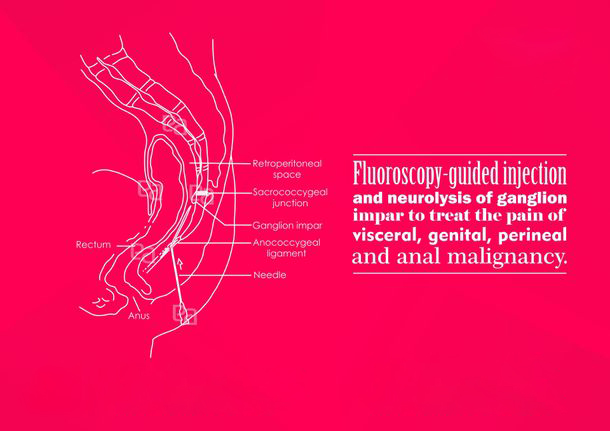

Treatments
ABDOMEN & PELVIC PAIN

Ganglion Impar Block
What is a Ganglion Impar block?
A ganglion impar block is an injection to treat pelvic pain, genital pain, perineal pain and anal pain. It is used to block the sympathetic nerves in the treatment of pain secondary to cancer, nerve damage, and prolonged post surgery pain. The main symptoms that respond are a vague and poorly localised pain in the “seat” region, which is burning in character and frequently accompanied by sensations of urgency with urination and/or passing motion. The nerve block can be diagnostic or therapeutic. If you experience benefit for a few months after the injection, it could be repeated.
How is Ganglion Impar block done?
At Atlas Pain Care, you will be asked to lie on your tummy in the procedure room. Your back will be cleaned with antiseptic and sterilely draped. The doctor will then use an X-ray machine (fluoroscope) to guide the needle into the correct spot. An X-ray contrast (dye) may be injected at this point to confirm that the needle has been positioned correctly. Medicines are then injected through the needle, and the needle is removed. The procedure should take 10 to 15 minutes.
What happens after the Ganglion Impar block?
After the procedure, you will be shifted to recovery area. You will remain there for 5 to 15 minutes before being discharged home. You might have some local tenderness from the needles and might require icing. You may also resume all of your medications. Your pain may improve immediately after the injection or a few days later.
What are the risks of the procedure?
There is a remote risk of bleeding, infection, nerve injury or an allergic reaction to the medications used. Some short-term side effects may occur, as well. The injection of local anaesthetic onto the nerve may cause some numbness that follows the path of the nerve that was blocked. You may have increased pain for a few days after the injection, including localised pain at the injection site. Please read our FAQ section to know more about the do's and don'ts prior to and after the procedure.

